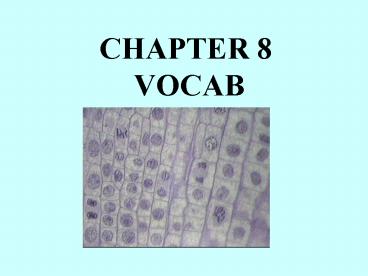CHAPTER 8 VOCAB PowerPoint PPT Presentation
Title: CHAPTER 8 VOCAB
1
CHAPTER 8 VOCAB
2
8-1 and 8-2MITOSIS VOCAB
3
- Chromosomes that determine the sex of an organism
Sex chromosomes
2 matching chromosomes that are the same size,
same shape, and carry genes for the same traits.
HOMOLOGOUS
4
- Proteins that help DNA wrap up into chromosomes
histones
2 identical arms that make up a chromosome
chromatids
5
- Chromosomes that are not the
- sex chromosomes
autosomes
An organized picture of an organisms chromosomes
karyotype
6
- Proteins that control the activity
- of a segment of DNA by turning genes on and off.
Non-histones
Spot in the center of a chromosome that holds the
chromatid arms together
centromere
7
- Phase of mitosis in which two nuclei are visible,
the nucleus returns, spindle fibers disappear,
and DNA spreads out as chromatin
telophase
Pinched in place in an animal cellmembrane
during cytokinesis
Cleavage furrow
8
- Cells that have 2 copies of eachchromosome
Diploid or 2n
Type of division seen in bacteria
Binary fission
9
- Phase in which the cytoplasm issplit between the
2 daughter cells
cytokinesis
1st phase of mitosis in which thenucleus
disappears and centrioles and spindle fibers
appear.
prophase
10
- Type of nuclear division that produces 2 daughter
cells that are genetically identical to the
parent cell
mitosis
Type of nuclear division that producesfour
daughter cells that have ½ the number of
chromosomes as the parent cell
meiosis
11
- Cells that have only one copy ofeach chromosome
Haploid OR 1n
Repeating sequence of events that cells go
through during their lifetime
Cell cycle
12
- Phase in which the nucleus divides
mitosis
Phase in which cells grow and matureand where
they spend most of their life
G1
13
- Dark spots that appear next to the nucleus in an
animal cell during prophase which contain the
centrioles
centrosomes
Disc shaped protein in the centromereregion
where spindle fibers attach
kinetochore
14
- Phase in which the chromosomesline up in the
middle of the cell
metaphase
Phase in which cells make the molecules and
organelles needed forcell division
G2
15
- Phase in which the DNA is copied
S or SYNTHESIS
Phase in which cells leave the cycle and stop
dividing all together
G0
16
- Phase in which chromatids separate and move to
opposite ends of the cell
anaphase
Fibers made of microtubules whichpull the
chromosomes apart duringcell division
Spindle fibers
17
- Dividing wall that forms during cytokinesis in a
plant cell to separate the 2 daughter cells
Cell plate
DNA that is spread out in the nucleusof a
non-dividing cell
chromatin
18
- DNA that is scrunched up into bundles in a
dividing cell
chromosomes
Dark spot in the nucleus of a cell that makes
ribosomes
nucleolus
19
8-3 MEIOSIS VOCAB
20
- Reproductive cells like sperm or eggs
gametes
Pairing up of homologous chromosomes during
Prophase I of meiosis
synapsis
21
- The exchange of genetic material
- between homologous chromosomes
Crossing over
The pair of homologous chromosomes that forms
during synapsis
tetrad
22
- New mixtures of genetic material
Genetic recombination
The random separation of maternaland paternal
chromosomes duringAnaphase I.
Independent assortment
23
- The production of mature sperm
spermatogenesis
Type of reproduction that does not involve
meiosis or joining of gametes and genetic
material comes from only 1 parent
Asexual reproduction
24
- The production of mature eggs
oogenesis
The type of reproduction that involves the union
of gametes and combinesgenetic material from 2
parents
Sexual reproduction
25
- Small cells produced during oogenesis when the
cytoplasm divides unevenly which degenerate
Polar bodies
Type of cell division used to producegametes
meiosis
26
- Type of cell division used by organisms to grow
bigger, repair injuries, and replace worn out
cells.
mitosis

